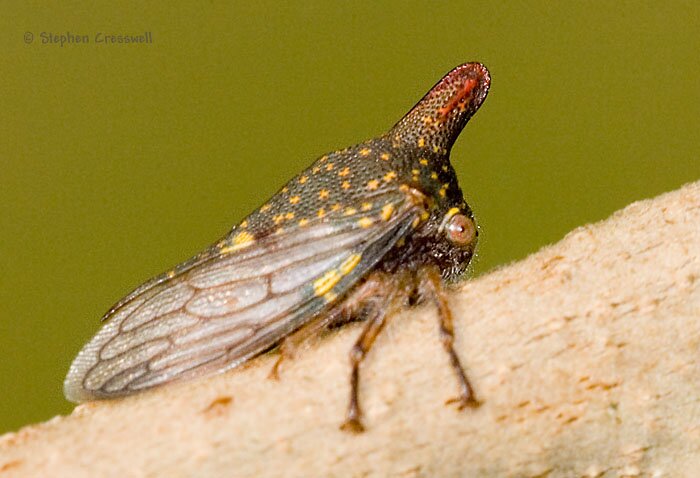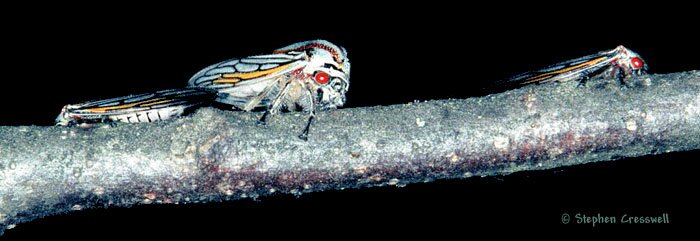
Family: Membracidae
Subfamily: Membracinae
Length: 10-13 mm
This species shows considerable variation from individual to individual, and from population to population. In the two photos here, note how the hopper above is spotted (gray and yellow) and the ones below striped in turquoise and red. Prominent horns are typically present in both color forms, but may be small or lacking in either color form.
Courtship and mating of Platycotis vittata takes place in the morning and evening hours.
Wood, et al. (1984) noted that many females of this species mate more than once, with the first mating often taking place even before the females ovaries are mature. The sperm of the last male to mate with a female, however, is the sperm that is used to fertilize the eggs.
Wood and his colleagues reasoned that the early matings were "insurance," with the sperm stored for possible use after the ovaries have matured. This "insurance mating" is necessary because males tend not to live as long as females, and females may not be able to find a mate after the ovaries are mature. However, if the late season mating does take place, it is with a male that presumably has superior genes for longevity, and these are the sperm used to fertilize the eggs.
Mating may last up to 24 hours, with the males apparently dragging out the process to prevent another male from mating with the female. Platycotis vittata also has an unusually long "waiting period" between mating and oviposition, ranging from an average of 29 days for females who mated more than once, to 39 days for females who mated just once. Females lay about 40 eggs each.
The mating habits of Platycotis vittata seem related to the life history of its host plants, Oaks. Overwintering adults emerge from the dead leaves on the forest floor in early Spring and the females oviposit, with the nymphs hatching out just as the Oaks are sending nutrients from the roots to the leaves. By late June the phloem is less nutritious (containing tanins, for one thing) and this may be a reason for the females slow maturing. The Spring-hatched treehopper females oviposit in August and the nymphs hatch out in September, in time to feed as the tree sends nutrients from the canopy to the roots.
Kopp and Yonke (1973) reported watching the spotted color form of these hoppers over a nine day period, and during that time the orange spots gave way to the reddish stripes. In other words, hoppers that looked like those in the upper photo became hoppers that look like those in the photo below. Kopp and Yonke thus agreed with a 1920 writer who had asserted that the color varieties werent really color varieties, but older and younger forms of the adult Platycotis vittata. Kopp and Yonke added, "The presence or absence of the pronotal horn, however, is not understood."
DNA studies by Chung-ping Lin et al. (2007) suggest that Platycotis vittata is a valid species, with relatively little genetic variation between individuals of the species, compared with individuals of the same genus but different species. They suggest a Central American origin for Platycotis vittata, with the species having expanded north to the Gulf of Mexico and the Pacific coast of California, and later expanding its range to include Arizona, the Ozarks, and the eastern United States.
The species is most often found living on Oaks, but there are some records of River Birch and Chestnut as hosts.



